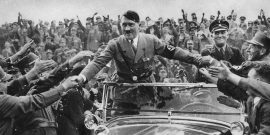The man who combined the conservative’s emphasis on order with the classical liberal’s attention to liberty.
Miracle Men: How Market Liberals Saved Germany from Economic Catastrophe
Seventy years ago this month, a small group of economists and legal scholars helped bring about what’s now widely known as the Wirtschaftswunder, the “German economic miracle.” Even among many Germans, names like Walter Eucken, Wilhelm Röpke, and Franz Böhm are unfamiliar today. But it’s largely thanks to their relentless advocacy of market liberalization in 1948 that what was then West Germany escaped an economic abyss and turned into Continental Europe’s largest and most dynamic economy.
The Great Reform, as Röpke often called it, wasn’t a matter of luck. It was a rare instance of free market intellectuals’ playing a decisive role in liberating an economy from decades of interventionist and collectivist policies. What makes their achievement even more extraordinary is that their policy prescriptions—a root-and-branch currency reform, the abolition of price-controls, widespread economic deregulation, and major reductions in marginal taxes—were implemented in the face of opposition from not just the entire German Left but many in the Christian Democratic movement that would rule West Germany without interruption from 1949 until 1969.
So the miracle wasn’t only the Great Reform’s spectacular economic results. It was that a small group of free market thinkers and an even smaller group of policymakers took on the German political, economic, and academic establishment.
A Different Market Liberalism
The reforms implemented on June 20, 1948, by Ludwig Erhard, future West German finance minister and Chancellor, in the zones of a still-occupied postwar Germany that were administered by the British and the Americans, represented the playing out of some specifically German currents of free market thought. Those who called themselves “ordo-liberals” or “neo-liberals” didn’t agree about everything, but they did share important commonalities distinguishing them from other free market thinkers.
In the first place, German market liberals developed their ideas in response to problems that manifested themselves in Germany before 1914 but that had been exacerbated by two world wars and the pursuit of corporatist, interventionist, and economic nationalist policies before and during the Nazi era. According to these market liberals, such problems—the cartelization of much of the German economy, rampant protectionism, price- and wage-controls—didn’t just result from mistaken economic policy. They reflected longstanding tensions in German political culture.
A second and related trait was their focus on the question of what type of order was needed to sustain a free economy. As Böhm, a legal scholar, wrote retrospectively: “The question with which we were all concerned boiled down to the question of private power in a free society. It inevitably raised further questions concerning the nature of order in a free society, the various types of economic order which exist, and the dysfunctions which may occur in these various types.”
Böhm and others concluded that market economies had to be protected from private actors—businesses, unions, agricultural lobbies—intent on rigging the system in their favor. Their most famous example was the way in which German steel and coal businesses had exploited their political connections and contract law to cartelize their respective industries. Once this process received legal ratification from the German Supreme Court in 1897, cartelization spread rapidly throughout the economy. The consequences for competition and economic liberty in Germany were calamitous.
Resisting these pressures required, according to Böhm and also Eucken (the two were colleagues at the University of Freiburg) certain institutional choices: The first was in favor of a competitive order and against top-down planning. The second concerned prioritizing monetary stability. The third choice needed to be for a state strong enough to prevent interest groups from capturing and corrupting market processes but which wouldn’t succumb to the temptation to meddle endlessly in the economy. These three emphases reflected the German market liberals’ conviction that questions of constitutional and institutional design were decisive for the character of economic life in a given society.
From Theory to Politics
Many of these ideas were worked out during the Nazi dictatorship. Some market liberals, like Röpke and Alexander Rüstow, did so in the relative safety of exile. Those who remained in Germany had to develop their economic theories “below the radar,” partly because their views directly clashed with the regime’s economic policies but also because of their more general anti-Nazi stances. But whether inside or outside Germany, these men arrived at a remarkably similar set of conclusions about how to shift Germany back toward free markets.
Those inside Nazi Germany combined this intellectual activity with the work of identifying market-friendly figures in German industrial, conservative, and Christian anti-Nazi circles who might be in a position to implement market-liberalization reforms if Germany lost the war. This was dangerous, not least because such activities could be seen as defeatist. It also brought them into contact with figures like Pastor Dietrich Bonhoeffer, Carl Goerdeler, and others who were executed following the attempt of the Catholic army officer, Colonel Claus von Stauffenberg, to assassinate Hitler on July 20, 1944.
Perhaps the most prominent of these market-friendly individuals was the aforementioned Ludwig Erhard, an economist and business executive who moved easily between the worlds of industry, policy, and ideas but who had refused to join the Nazi party. A careful reader of the writings of Eucken and Röpke, Erhard viewed the postwar period as a once-in-lifetime opportunity to introduce far-reaching reforms that would otherwise have been difficult to realize.
Not that reform was going to be easy: in 1945, few Germans were amenable to the free market. The Social Democratic Party emerged from the catacombs wanting more top-down economic planning, not less. Many of those Germans who eventually coalesced under the Christian Democratic banner were equally hostile to anything that smacked of “capitalism.” They remained deeply influenced by the highly corporatist expressions of Catholic social thought that dominated German-speaking Catholicism. Others promoted Christian socialism or even a “third way.” Then there were those such as the man who would become West Germany’s first Chancellor, Konrad Adenauer, who viewed economic questions largely through the lens of political expediency.
Further complicating matters was the fact that the military authorities in the Western-occupied zones in Germany, with many Keynesians in their contingent, admired the economic policies of Clement Atlee’s Labour government in Britain. Indeed, between 1945 and 1947, the Allied administrators left largely in place the partly collectivized, state-oriented economy put in place by the defeated Nazis. This included price-controls, widespread rationing, and continued use of the Nazi-era, inflation-riddled currency.
These features of the postwar German economy discouraged investment, capital growth, and competition. They also made Germans disinclined to go beyond barter-like exchanges. Farmers were even reluctant to sell their produce. The result was widespread food shortages and soaring malnutrition levels.
Despite these inauspicious circumstances, German market liberals showed themselves adept at advancing their ideas on several fronts. They proved highly skilled at securing important positions in the economic administration and advisory councils created by the Western Allies. Erhard, for instance, emphasized his impeccable anti-Nazi credentials to become Bavaria’s finance minister in 1945. Such maneuvering enabled market liberals to exercise an influence upon economic policy beyond their actual numbers.
Just as important was the effort of market liberals to advance the case for economic liberalization in the public square. In May 1948, Eucken and Böhm launched the journal Ordo to promote free market ideas among the influential German professoriate. Looking beyond the academic scene, German market liberals wrote long opinion pieces in quality newspapers like the Zurich-based Neue Zürcher Zeitung that catered to educated and politically engaged audiences. One reason why Röpke chose to publish often in that newspaper was his knowledge that Adenauer read it avidly.
Nor were those bent on market reforms afraid to engage the broader public. Erhard delivered radio broadcasts designed to persuade mass audiences of the case for free markets. The reformers were also careful not to ignore those less prestigious publications read by the hundreds of thousands of Germans who would never browse the Neue Zürcher Zeitung.
On December 13, 1947, for example, the widely circulated Catholic weekly Rheinische Merkur published a critique by Röpke of Günter Keiser, the foremost economist opposing Erhard’s proposals to abolish wartime economic regulations. Today this article is considered one of the most important pieces which helped prepare German public opinion for Erhard’s liberalizing measures the following year. Not mincing his words, Röpke informed his readers that “If we maintain the command economy, then we maintain the world of economic fantasy.”
Successes and Lessons
The most well-known of Erhard’s June 1948 reforms were his abolition of price-controls and the replacement of the Nazi-era Reichsmark with much smaller quantities of a new currency: the Deutsche Mark. These measures effectively killed off the inflation that permeated the German economy.
The effects of these and other liberalizing changes were almost immediate. Farmers, for instance, suddenly started selling produce because they now knew the real price of their goods. They also recognized that the value of the money they earned for their goods wasn’t being pulverized by inflation.
In German cities, employees began turning up for work because they were being paid in a currency that retained its purchasing power. No longer did they need to spend work-hours scrounging for food to feed their families. Within six months, industrial production had increased by an incredible 50 percent. Real incomes started growing. The contrast with the ruinous economic situation prevailing in what would become the German Democratic Republic was hard even for Social Democrats to deny.
The irony is that none of the German market liberals regarded the Wirtschaftswunder as extraordinary. For people like Erhard, Eucken, and Röpke, it was simply the logical consequence of getting the basic foundations of a market economy in place and allowing the German people to do the rest.
And therein perhaps lies the German economic miracle’s primary lesson for us today. Many contemporary free market advocates focus on the micro-details of policy in realms ranging from healthcare to antitrust law. That’s understandable, given that such details affect millions of people. That said, the German market liberals who triumphed against the odds in 1948 teach us not to lose sight of the broad institutional framework within which economies function. For if an economy’s fundamentals are defective, no amount of policy tinkering will save us from the disastrous effects of chronic monetary instability, state-determined prices, punitive tax levels, or collectivized property arrangements.
Put another way, liberty and the flourishing which it allows depend upon the right type of underlying order far more than we realize—including in the economy.


